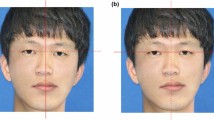Abstract
Background
Rhinoplasty planning requires meticulous forethought and is a source of challenge to surgeons. Traditional anthropometric analyses aim to use measurements and ideal ratios to determine the appropriate changes in nasal measurements such as length and tip projection. More recently, computerized photograph manipulation has been adopted as a means to demonstrate to patients the planned changes in a rhinoplasty and improve communication and patient confidence. It remains undetermined if the changes recommended using traditional anthropometric rhinoplasty planning are similar to those done by an experienced rhinoplasty surgeon manipulating preoperative photographs to an aesthetic ideal.
Methods
Preoperative photographs obtained for clinical use were analyzed from 97 consecutive patients seen in clinic for rhinoplasty or septorhinoplasty by the senior author (R.H.G.). Facial and nasal anthropometric measurements were performed on the preoperative photographs. The analysis prescribed by Byrd and Hobar was used to then calculate their prescribed “ideal” nasal anthropometrics. Separately, these patients had their preoperative photographs manipulated using computer manipulation software by the senior author, with an eye toward creating an aesthetically pleasing nose. Nasal anthropometrics were measured from the manipulated photographs. The changes prescribed in traditional anthropometrics were compared to those obtained from computer manipulation using univariate analyses.
Results
The mean patient age was 35.4 years, and the population was 68% female. Average nasal proportions from the computer manipulation were a nasal length 76.1% of the midfacial height, tip projection of 57.7% of nasal length, and radix projection of 24.3% of nasal length. Computerized manipulation minimally changed nasal length relative to Byrd’s analysis which decreased nasal length on average (100.3% of the original nasal length versus 88.2%, p<0.01). It prescribed a greater decrease in tip projection than Byrd’s analysis (97.7% of original projection versus 99.9% of original projection, p=0.05). Computer manipulation also prescribed a lesser increase in radix projection than Byrd’s analysis (100.5% of original radix projection versus 109.3% of original radix projection, p<0.01).
Conclusions
Byrd’s analysis remains an excellent tool for guiding the changes in nasal dimensions in rhinoplasty. However, computerized manipulation may help patients and surgeons communicate a common goal. Their desired nasal dimensions may differ from those traditionally prescribed. Specifically, some patients may seek lesser decreases in nasal length or lesser increases in radix projection than Byrd’s analysis prescribes. Further research in this topic is warranted, and ultimately the surgeon’s judgment and patient goals should drive surgical planning.
Level of Evidence IV
This journal requires that authors assign a level of evidence to each article. For a full description of these Evidence-Based Medicine ratings, please refer to the Table of Contents or the online Instructions to Authors - www.springer.com/00266.



Similar content being viewed by others
References
Byrd HS, Hobar PC (1993) Rhinoplasty: a practical guide for surgical planning. Plast Reconstr Surg 91(4):642–654
Pawar SS, Garcia GJM, Kimbell JS, Rhee JS (2010) Objective measures in aesthetic and functional nasal surgery: perspectives on nasal form and function. Facial Plast Surg 26(4):320–327
Meruane M, Ayala MF, García-Huidobro MA, Andrades P (2016) Reliability of nasofacial analysis using Rhinobase® Software. Aesthetic Plast Surg 40(1):149–156
Chisholm E, Jallali N (2012) Rhinoplasty and septorhinoplasty outcome evaluation. Ear, Nose Throat J 91(3):E10–E14
Moscatiello F, Jover JH, Ballester MAG, Hernández EC, Piombino P, Califano L (2010) Preoperative digital three-dimensional planning for rhinoplasty. Aesthetic Plast Surg 34(2):232–238
Cingi CC, Cingi C, Muluk NB (2014) Cingi Steps for preoperative computer-assisted image editing before reduction rhinoplasty. Int Forum Allergy Rhinol 4(4):329–332
Bitik O, Uzun H, Kamburoglu HO, Çalis M, Zins JE (2015) Revisiting the role of columellar strut graft in primary open approach rhinoplasty. Plast Reconstr Surg 135(4):987–997
Unger JG, Lee MR, Kwon RK, Rohrich RJ (2012) A multivariate analysis of nasal tip deprojection. Plast Reconstr Surg 129(5):1163–1167
Rohrich RJ, Ahmad J (2016) A practical approach to rhinoplasty. Plast Reconstr Surg 137(4):725e–746e
Author information
Authors and Affiliations
Corresponding author
Ethics declarations
Conflict of interest
The authors declare that they have no conflicts of interest to disclose.
Ethical Approval
IRB approval was sought and this study was deemed exempt from regulation.
Informed Consent
For this type of study informed consent is not required.
Consent for Publication
Consent was obtained and documented for use of patient photographs for publication.
Additional information
Publisher's Note
Springer Nature remains neutral with regard to jurisdictional claims in published maps and institutional affiliations.
Rights and permissions
About this article
Cite this article
Lisiecki, J.L., Gilman, R.H. Traditional Anthropometrics versus Computerized Photograph Manipulation in Rhinoplasty Planning. Aesth Plast Surg 46, 338–341 (2022). https://doi.org/10.1007/s00266-021-02563-2
Received:
Accepted:
Published:
Issue Date:
DOI: https://doi.org/10.1007/s00266-021-02563-2




